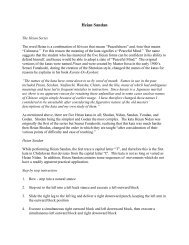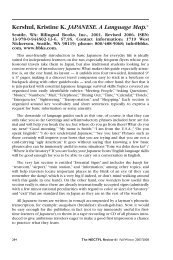selected paintings - Dickinson College
selected paintings - Dickinson College
selected paintings - Dickinson College
You also want an ePaper? Increase the reach of your titles
YUMPU automatically turns print PDFs into web optimized ePapers that Google loves.
6<br />
A Quiet Street Corner, Boston, n.d.<br />
Oil on masonite, 24 x 19 1/2 in. (60.9 x 49.5 cm)<br />
Signed: l.r.: Quincy<br />
Exhibited: Spirit of the Past: The Paintings of Edmund Quincy, 1903-1997 (New<br />
York: Hirschl & Adler Galleries, 2000).<br />
Published: Zachary D. Ross, Spirit of the Past: The Paintings of Edmund Quincy,<br />
1903-1997 exh. cat. (New York: Hirschl & Adler Galleries, 2000), 8,<br />
cat. 22.<br />
Courtesy of Hirschl & Adler Galleries, NYC<br />
A Quiet Street Corner, Boston is another cityscape by Edmund<br />
Quincy that depicts the artist’s hometown of Boston,<br />
Massachusetts. As a result of his ancestry and his family’s prominent<br />
position in this city, Quincy had a unique relationship<br />
with Boston, and his personal experiences shaped his perception<br />
of the city and influenced the way he presented it to his viewers.<br />
Quincy’s images of Boston vary greatly in both their style and<br />
location as the artist sometimes portrayed the more familiar<br />
areas of the city, while at other times he focused on the city’s<br />
quieter, more obscure neighborhoods. A Quiet Street Corner,<br />
Boston is an example of the latter category.<br />
A Quiet Street Corner, Boston depicts a residential neighborhood<br />
in Boston, one that contrasts greatly with the prominent<br />
and lively regions of the city such as that illustrated in Street<br />
Scene, Boston. Removed from the more visible and well-known<br />
areas located in the center of Boston, this neighborhood represents<br />
the type of environment in which the artist might have<br />
grown up. From a frontal viewpoint, Quincy presents a row of<br />
houses. These houses are exclusive brownstones inhabited by<br />
elite Bostonians. Two figures, a man and a woman, walk side by<br />
side down the street that runs in front of the houses. In A Quiet<br />
Street Corner, Boston, Quincy used a more subdued color palette<br />
than that in some of his other Boston <strong>paintings</strong>, with dark burgundies,<br />
browns, oranges, and grays making up the image. This<br />
work appears to be a study in tonality, and the harmonious<br />
blending of the different tones, together with the soft, natural<br />
light, create a very calm, almost somber atmosphere.<br />
In 1930, Quincy had his first one-man show at the Galerie<br />
d’Art Contemporain in Paris, in which he exhibited many<br />
<strong>paintings</strong> of Boston and its environs. 1 Although it is not precisely<br />
known which works were exhibited, A Quiet Street Corner,<br />
Boston is probably similar to many of the Boston <strong>paintings</strong> that<br />
were shown. This exhibition drew a lot of attention from the<br />
press in both America and France, which overwhelmingly<br />
praised Quincy’s depiction of the quieter, more intimate areas of<br />
Boston. As the critics observed, Quincy gave “an attractive<br />
image of that country [America] not of the tumultuousness of a<br />
big city, but an aspect more intimate, more pleasant, more picturesque.”<br />
2 A Quiet Street Corner, Boston is an example of these<br />
more intimate, picturesque portrayals of America that have been<br />
attributed to Quincy. This work focuses not on the urbanization<br />
and industrialization of the city but instead presents, simply and<br />
16<br />
clearly, a small residential neighborhood in Boston, a place that<br />
for Quincy represented the tradition of a city in which his family<br />
had been involved for generations.<br />
Edward Hopper, an American artist and contemporary of<br />
Quincy with whom Quincy has often been compared, was also<br />
known for his depictions of the quieter, more isolated regions of<br />
a city and its surroundings. 3 However, while Hopper’s imagery<br />
is often seen to embody a psychological isolation produced by<br />
his empty spaces, Quincy seemed to portray the more obscure<br />
neighborhoods in Boston in order to highlight the beauty and<br />
value of these areas, which for him represented his childhood<br />
and the Boston that he called home. As Thomas Devine noted<br />
in a newspaper article from 1930, in Quincy’s images of Boston,<br />
The choice of subject is not the obvious beauty of Beacon Hill<br />
or the Embankment but rather in spots which many of us pass<br />
every day without a thought of their charm. We admire the<br />
Hill and the Back Bay because it is fashionable to do so; but<br />
we scorn the South End and South Boston, which are quite as<br />
lovely, because we lack the perception to appreciate them until<br />
such a painter as Quincy points them out to us. 4<br />
While outwardly A Quiet Street Corner, Boston may seem<br />
less celebratory than some of Quincy’s other <strong>paintings</strong> of<br />
Boston, such as Street Scene, Boston, because of its simplicity of<br />
imagery and subdued color palette, this image is still a revealing<br />
portrayal of city life that serves as an indicator of the artist’s<br />
appreciation for quieter neighborhoods like the one depicted.<br />
In contrast to many of Quincy’s cityscapes and landscapes,<br />
with their dramatic perspective and aerial viewpoint, A Quiet<br />
Street Corner, Boston has a direct, frontal vantage point. Childe<br />
Hassam, a slightly older contemporary who exhibited alongside<br />
Quincy in at least one major exhibition, often painted images of<br />
the city from an above perspective looking down, with sharp<br />
angles that delineated the city streets. 5 These images are compositionally<br />
similar to many of Quincy’s <strong>paintings</strong>. However, in<br />
some of Hassam’s cityscapes, such as Little Cobbler’s Shop from<br />
1910, the artist chose to present areas of New York from a<br />
direct, frontal viewpoint. Ilene Susan Fort, author of Childe<br />
Hassam’s New York (1993), explains this deviation from Hassam’s<br />
typical compositions, arguing that Hassam occasionally chose to<br />
portray the city from a head-on vantage point so as to equate<br />
the quieter neighborhoods of the city with small town life: “By<br />
discarding his usual treatment of New York streets on a sharp<br />
diagonal or as part of a deep vista, Hassam equated these humble<br />
neighborhoods with small towns…Hassam was rejecting the<br />
new dynamism and congestion of the city…for a simpler, quiet<br />
place.” 6<br />
This same idea can be equally applied to Quincy’s A Quiet<br />
Street Corner, Boston. In his own writings, Quincy reveals a<br />
fondness for the old neighborhoods of Boston which, for him,<br />
represented a simpler life free from the changes occurring in<br />
urban society. In the early 1960s, Quincy returned to Boston






